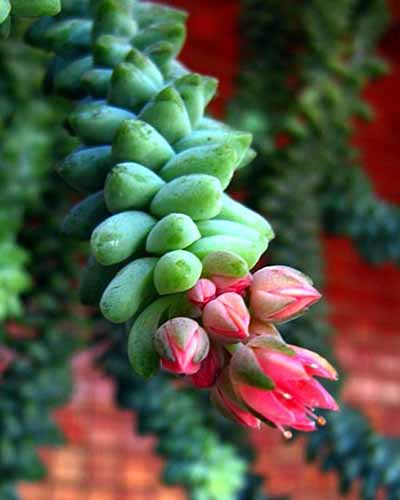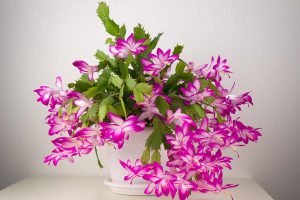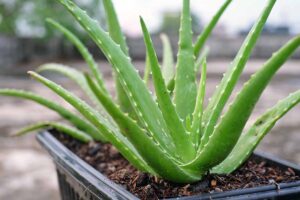Sedum morganianum
With its trailing stems and plump, bluish leaves, donkey’s tail sedum makes a striking houseplant that’s easy to care for.
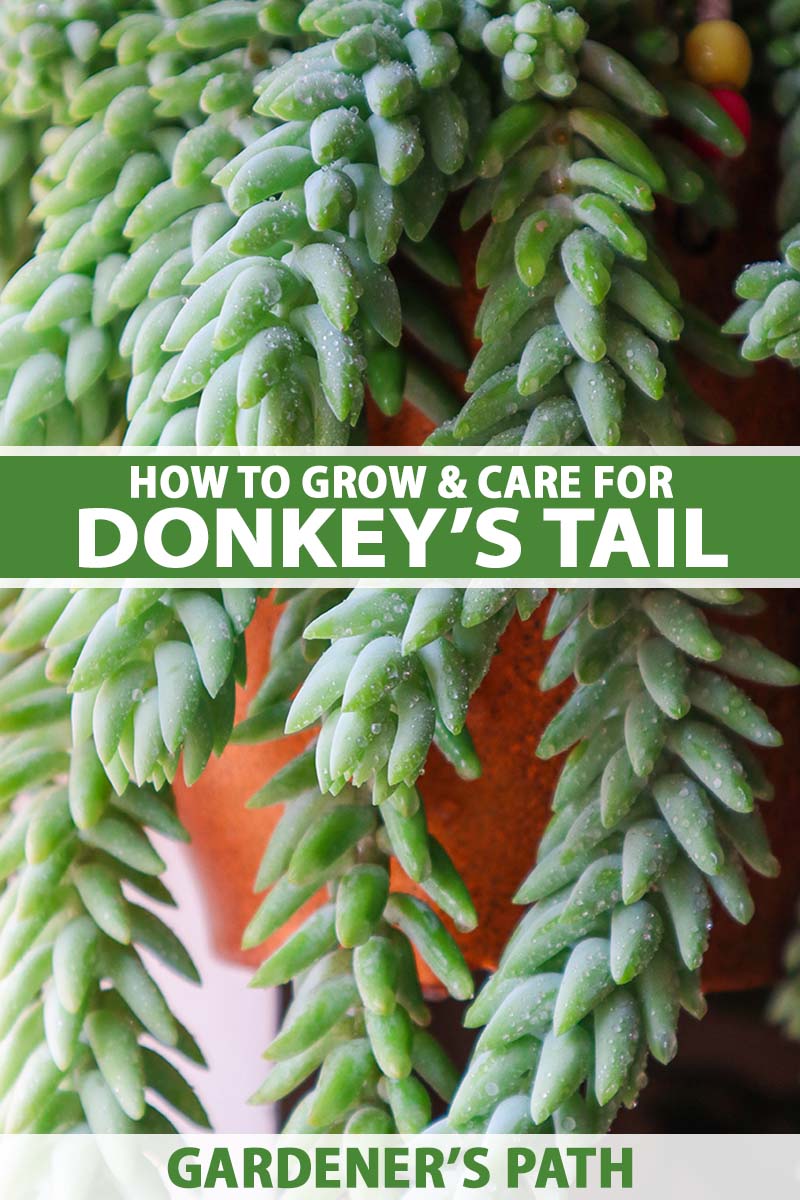
We link to vendors to help you find relevant products. If you buy from one of our links, we may earn a commission.
If succulents bring to mind visions of tiny rosettes, the impressive, trailing stems of donkey’s tail will expand your options, providing the perfect choice for a raised planter or hanging basket.
Plus, this succulent is nontoxic and fun to propagate!
In this article we’ll dig deep into the mysterious origins of this sedum as well as discussing its sun, water, and soil preferences.
We’ll also take up the daunting topic of repotting this delicate plant, cover other maintenance points you’ll want to know about – and even contemplate some captivating varieties.
Here’s a peek at everything that’s up ahead in this guide:
What You’ll Learn
What Is Donkey’s Tail?
Donkey’s tail (Sedum morganianum) is an evergreen succulent known for its long, trailing stems covered with fleshy leaves.
Mature specimens with long stems look like long braids or ropes hanging from baskets or planters.
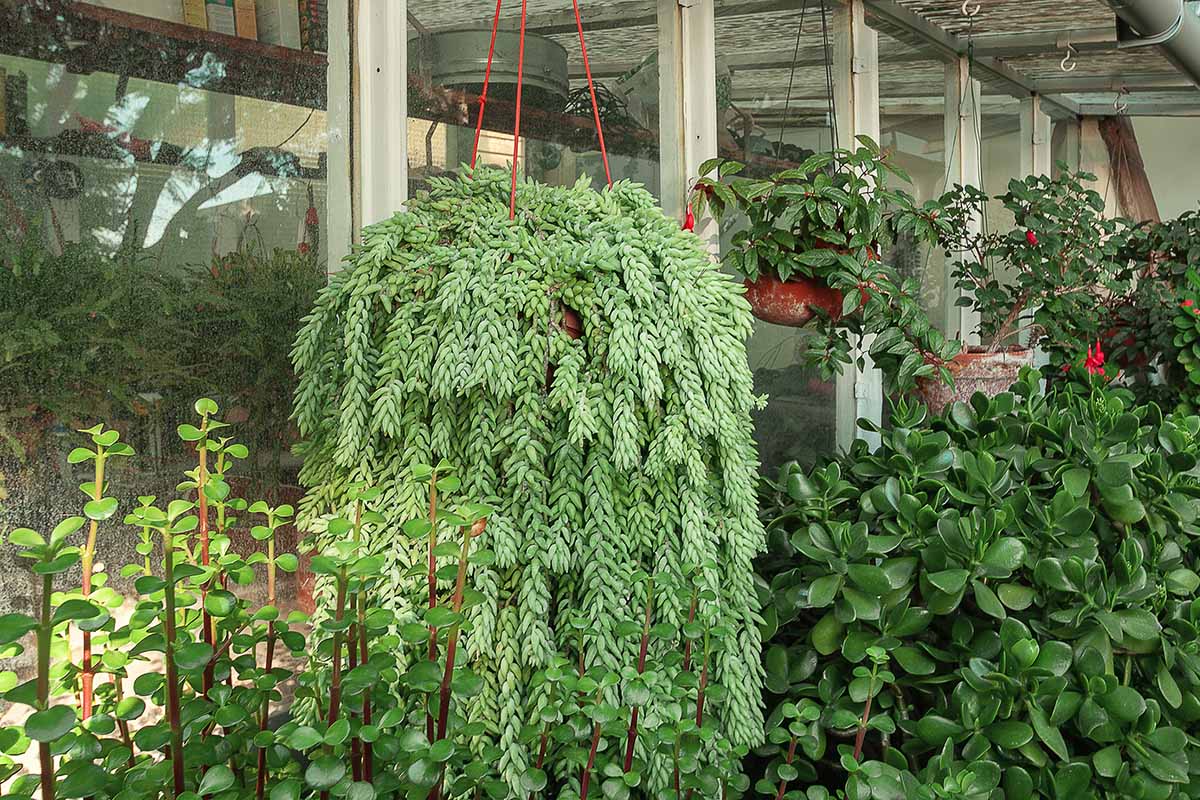
This succulent has bluish-green foliage that can have a powdery, whitish bloom.
Donkey’s tail’s plump leaves are smooth, curved, pointed at the ends, and overlap in their whorled arrangement around the plant’s stems.
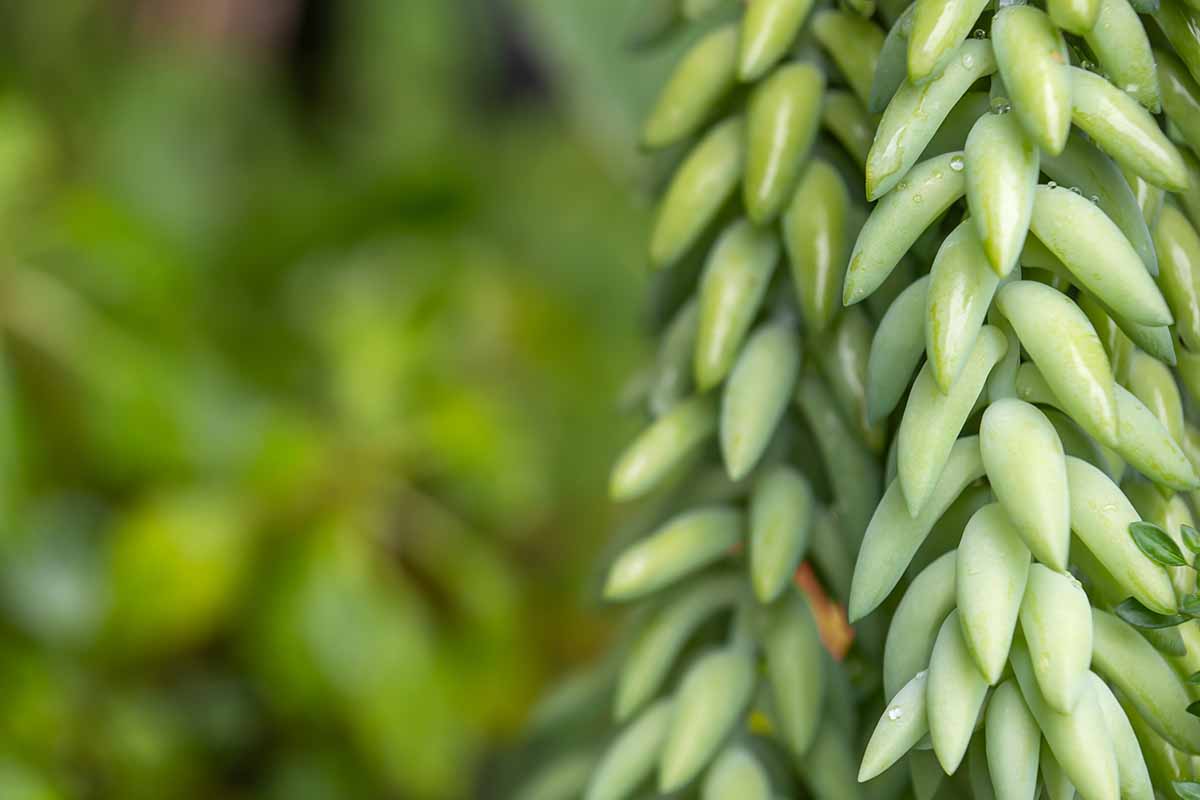
Plants have a weeping growth habit with a width of about one and a half feet.
Stems grow upright first, then trail and become pendulous, growing up to four feet long as houseplants.
But they can potentially grow much longer. In ideal conditions, S. morganianum can grow up to one foot a year.
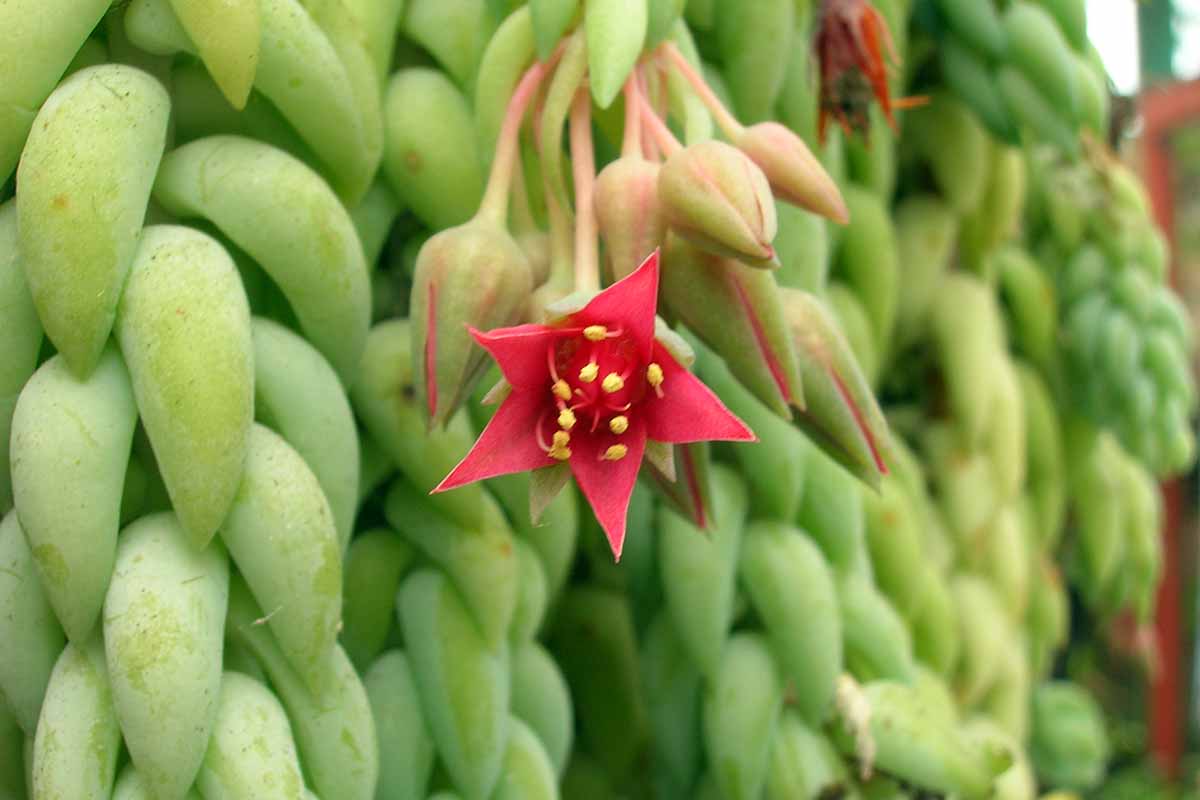
Though flowering is infrequent in houseplants, blooms are star-shaped and pink or red, growing in clusters at the ends of stems and appearing in late spring to early summer.
Cultivation and History
While we now know that S. morganianum is native to tropical deciduous forests in eastern Mexico, the exact origins of this species were quite a mystery for decades.
During a plant-hunting trip to Mexico in 1935, an American botanist by the name of Eric Walther encountered the succulent, blue-tinted vines of this species cascading out of tin cans at a small nursery in Veracruz.
Walther brought donkey’s tail specimens back to the US, where the plants eventually became popular ornamentals and houseplants.
Since then, botanists repeatedly attempted to find S. morganianum growing in its native range, but were unsuccessful.
Until 2008, that is.
By then, word had gotten around that a rancher had some specimens growing wild on his property. Botanists went to inspect the claim and verified that wild populations were growing from cliffs in two different ravines.
Because of its very limited native range, this plant is considered a “micro-endemic” species, meaning native wild populations are extremely limited in their range.
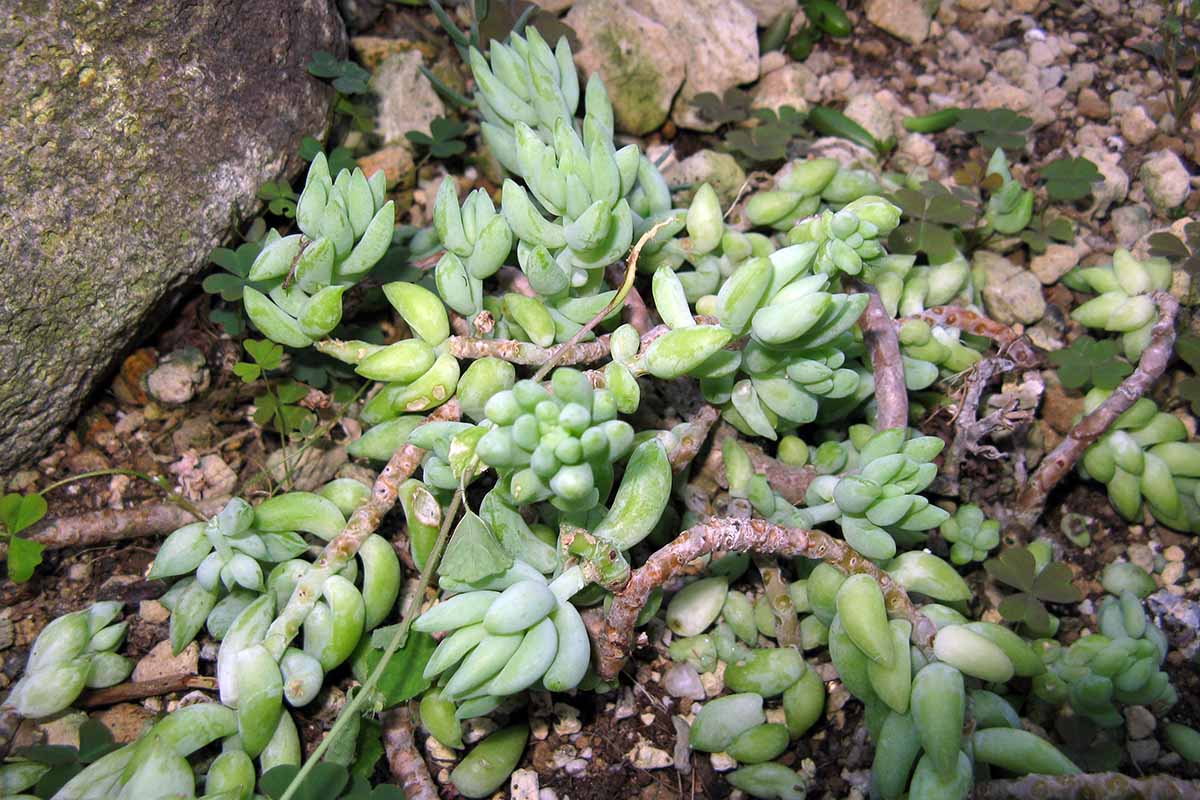
S. morganianum is a member of the stonecrop family, Crassulaceae, and is related to other succulents common in cultivation such as jade, panda plant, calico kitten, string of buttons, and watch chain.
In addition to its common name “donkey’s tail,” S. morganianum is also known as both “sheep’s tail” and “burro’s tail.”
This latter moniker can also refer to another plant, which is (depending on who you ask) either a variety of S. morganianum or a separate species. We’ll dive into their differences later in this article, so keep reading!
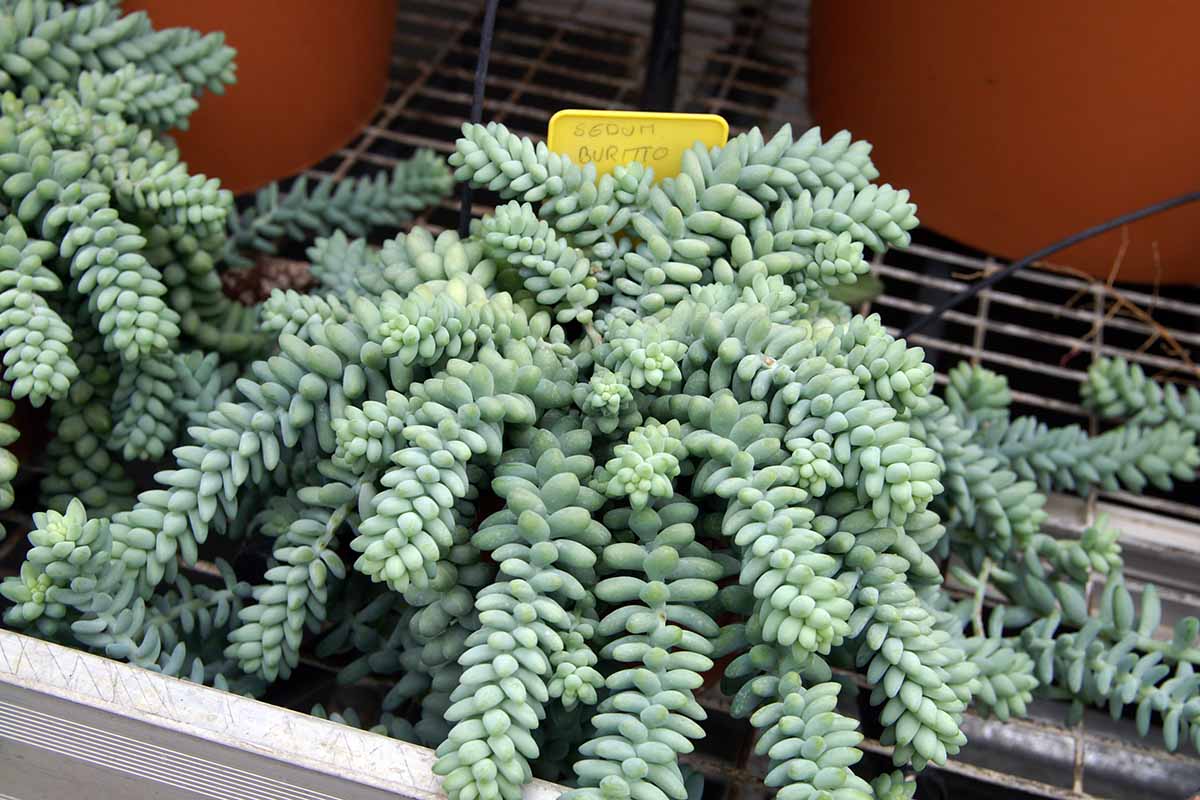
Classified botanically as Sedum morganianum, the genus name Sedum means “houseleek” in Latin, one of the common names for the popular succulents also known as hens and chicks (Sempervivum spp.).
Since Eric Walther – the botanist who brought this species to the US – bestowed it with its botanical name, you might expect that he took the route of so many other botanists and named the plant after himself.
But Walther must have been a humble fellow.
Instead, the species name morganianum honors Dr. Meredith Morgan, an optometrist and succulent enthusiast who was also the first to get the plant to flower in the US.
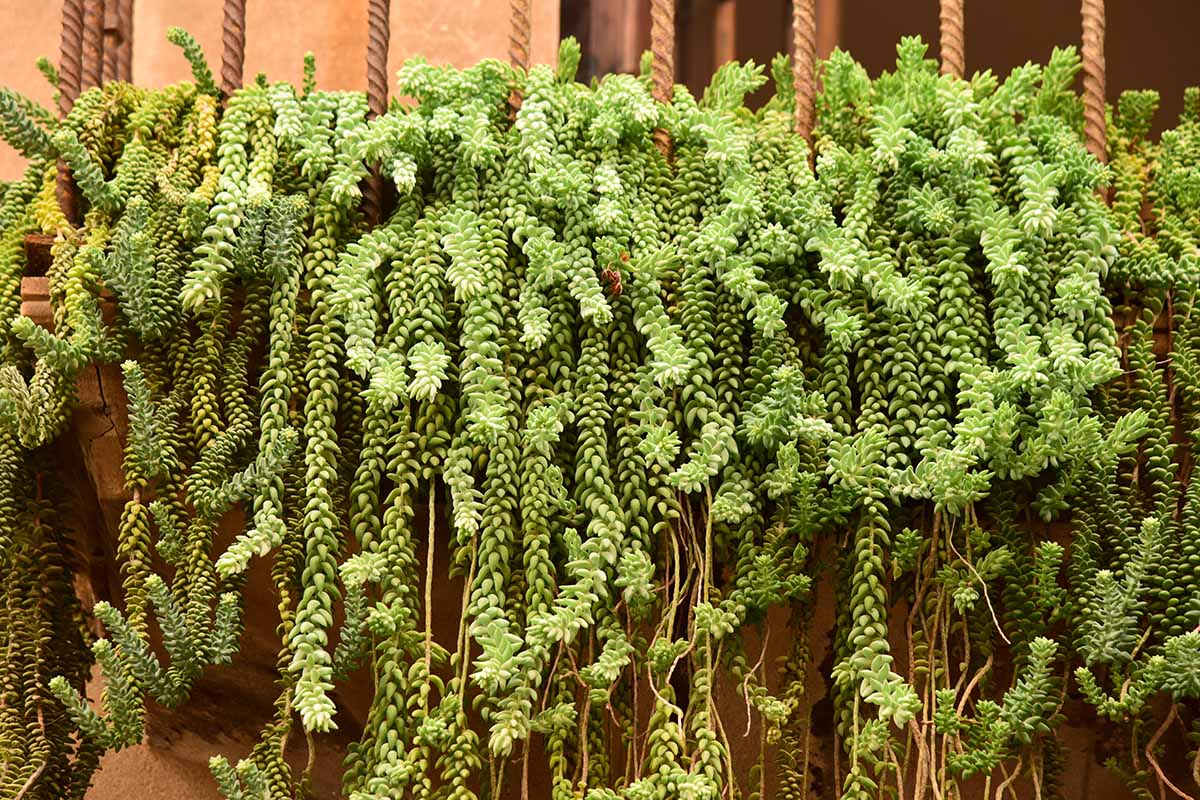
And speaking of honors, S. morganianum was granted the Royal Horticultural Society’s Award of Garden Merit in 1993.
While donkey’s tail is a popular houseplant, it can also be grown outdoors year-round in USDA Hardiness Zones 10b to 11a.
Propagation
Donkey’s tail is easily propagated from both stem and leaf cuttings. While propagation from seeds is also possible, these are quite difficult to obtain.
And since these succulents are opportunistic growers, able to produce new plants from fallen leaves or broken lengths of stem, propagating new plants from cuttings simply takes advantage of one of the plant’s inherent reproductive strategies!
From Stem Cuttings
If you want to try the easiest method, propagating donkey’s tail from stem cuttings is the way to go.
Here’s what you’ll need for this project: cuttings of at least three inches in length, a suitable potting medium for cacti and succulents, small nursery pots, a misting bottle, and optionally, a chopstick.
Using sterilized scissors or garden pruners, take cuttings from freshly watered plants to ensure that they are well hydrated.
Cuttings can be any length you choose, but three-inch cuttings are easy to work with. Longer cuttings are heavier and may need to be pinned down to anchor them in place.
As for nursery pots, you can place one cutting in a two-inch nursery pot, or several in a four-inch nursery pot, to give the appearance of a fuller specimen. Ensure that containers provide good drainage.
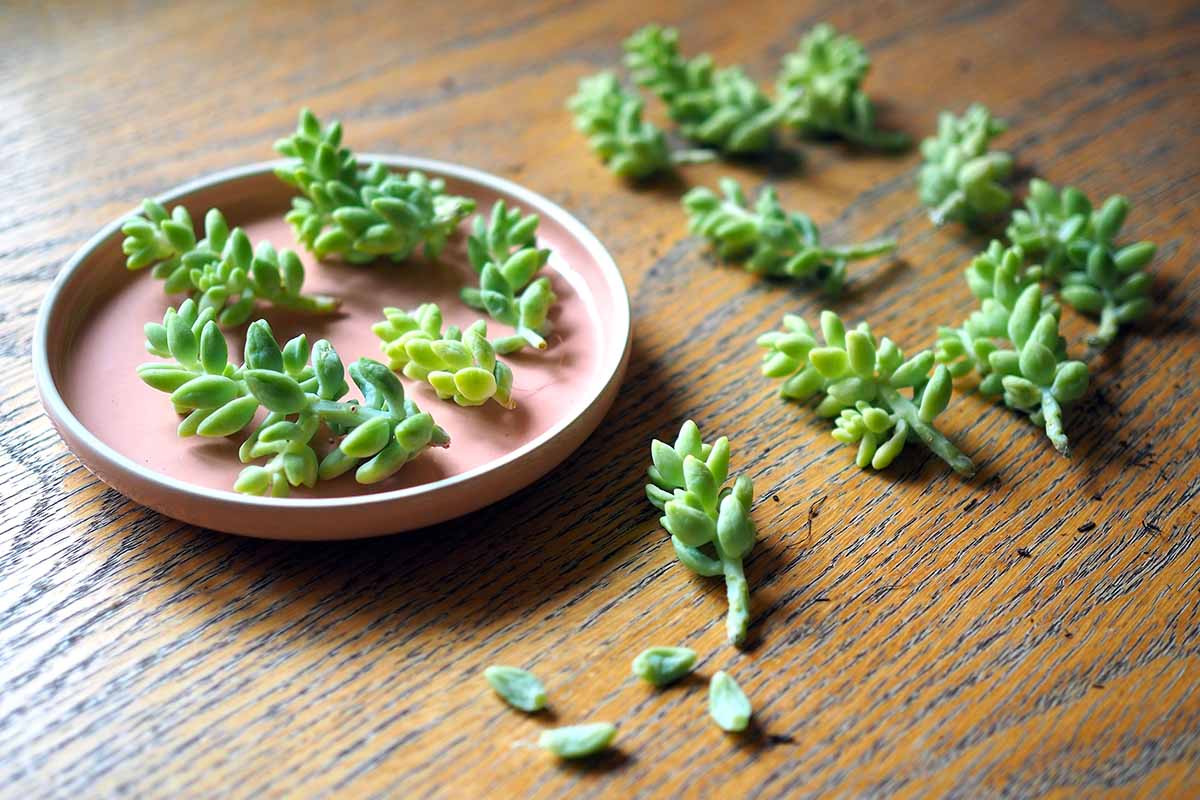
Set cuttings to the side in a dry location out of direct sunlight to allow them to callus over for two to three days.
When you’re ready to plant the cuttings, remove the bottom leaves to expose an inch or so of bare stem.
Fill the nursery pots with growing medium, leaving half an inch to an inch of space between the surface of the soil and the rim of the pot. Wet the potting medium so that it’s damp.
Insert the cuttings into the potting soil, spacing them out evenly if propagating several in one pot, or centering single cuttings. You can use your finger or a chopstick to make holes in the potting soil to insert the cuttings.
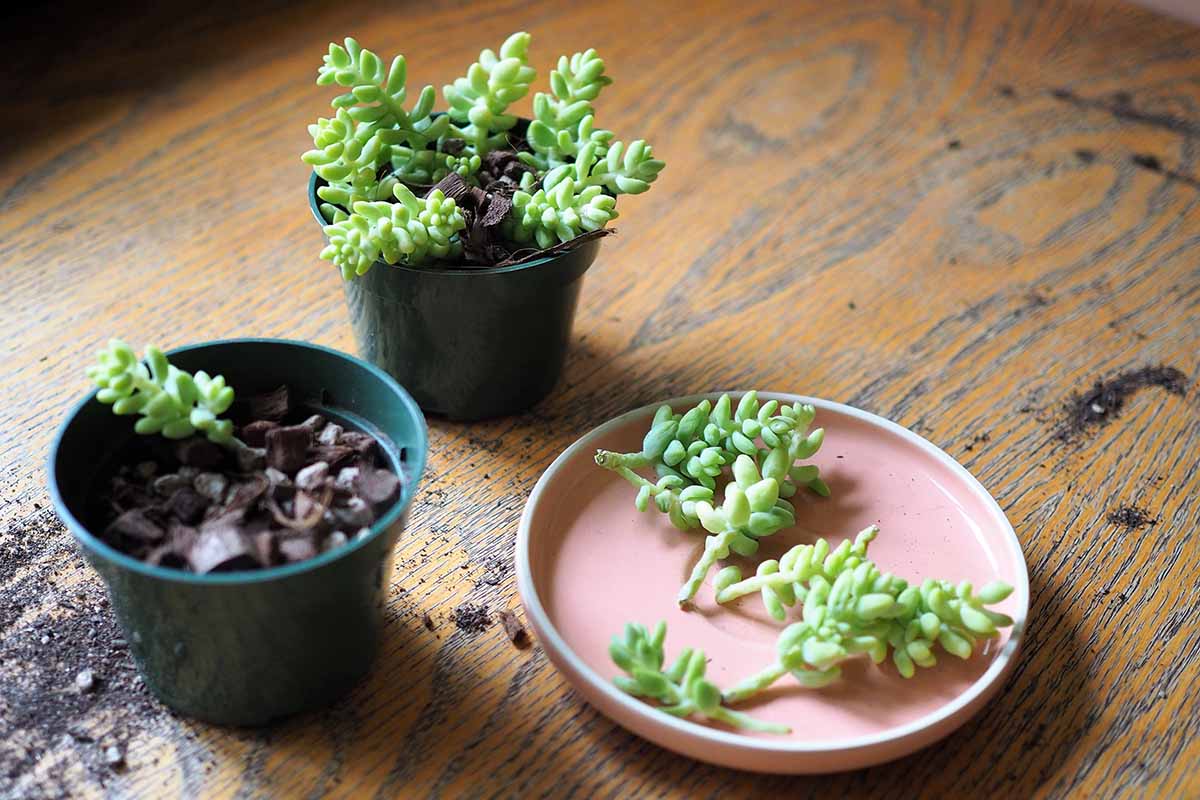
Situate the potted cuttings in bright, indirect light, and mist the soil around the cuttings whenever the surface feels dry.
It will take up to two weeks for the cuttings to root. Any cuttings that shrivel up and fail to root can be discarded.
From Leaf Cuttings
As you may have already discovered if you own a donkey’s tail specimen, the leaves of this succulent fall off very easily – it can seem that they fall off if you so much as look at the plant the wrong way!
Luckily, these leaves are easy to propagate so they don’t go to waste.
For this propagation method, in addition to leaves, you’ll need a suitable, porous potting medium, a nursery pot or tray, and a spray bottle.
As with stem propagation, this will be the most successful if you choose leaves from a plant that has been watered recently, so that they are nice and plump, full of water.
Also, make sure the leaves are intact throughout, particularly at the base.
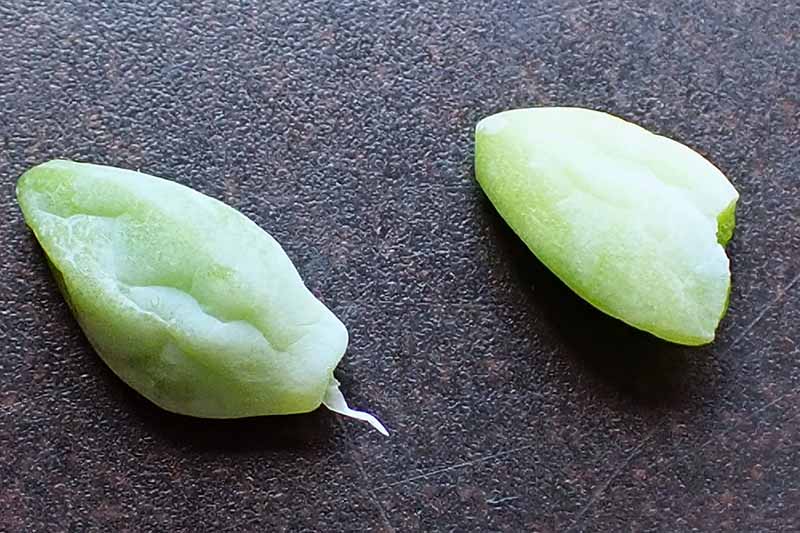
Broken leaves aren’t suitable for propagation, and they will fail to root.
Fill your nursery pot with damp growing medium, then place the leaves on top of the medium about an inch or so apart, or insert the base of each into the medium – either method will work.
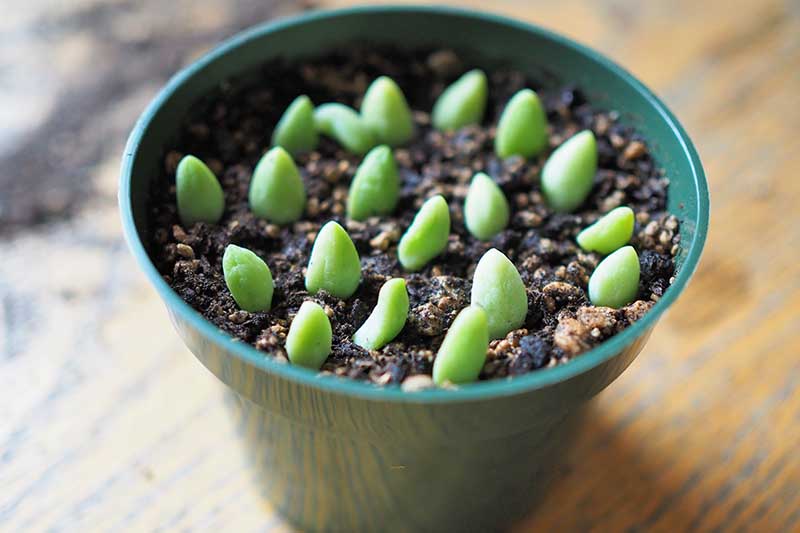
Whenever the surface of the soil dries out, spray it with water with your spray bottle to keep it moist.
Within a week or so, you will start to see roots emerging from the leaves, and after that, the buds of new plantlets as well.
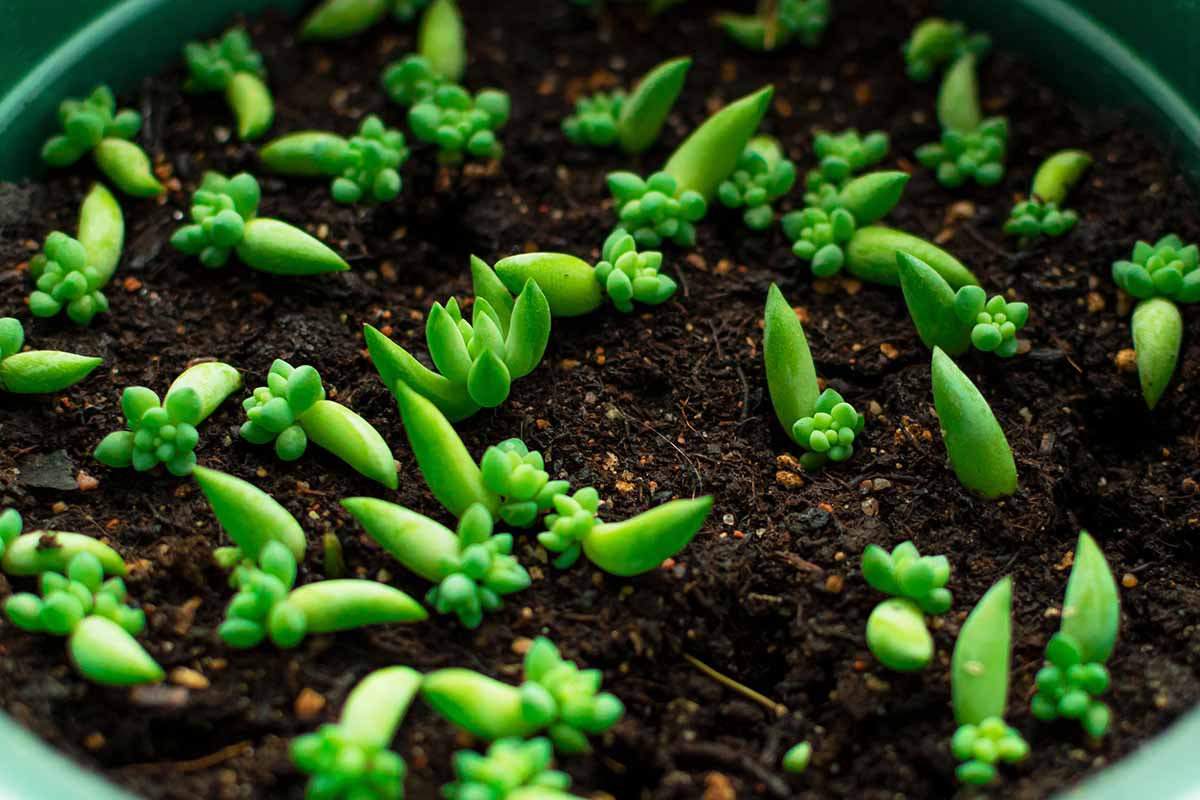
Each leaf may produce a new plantlet, and each new plantlet can be transplanted into a small pot, or you can combine several into one pot for a fuller looking houseplant.
It may take four weeks or more for plantlets to size up enough to be transplanted.
A spoon works well to help transplant these small plantlets. Be sure to space them out with a couple of inches between them to give them enough room to grow.
Need more tips? You can learn more about propagating succulents in our article!
How to Grow
Despite its very narrow native range, donkey’s tail is not a fussy houseplant, and is fairly flexible about its growing conditions. Here’s everything you need to know:
Sun
Grow donkey’s tail in bright, indirect light.
It can also tolerate some direct sun if temperatures aren’t too high – up to four hours of direct sun per day.
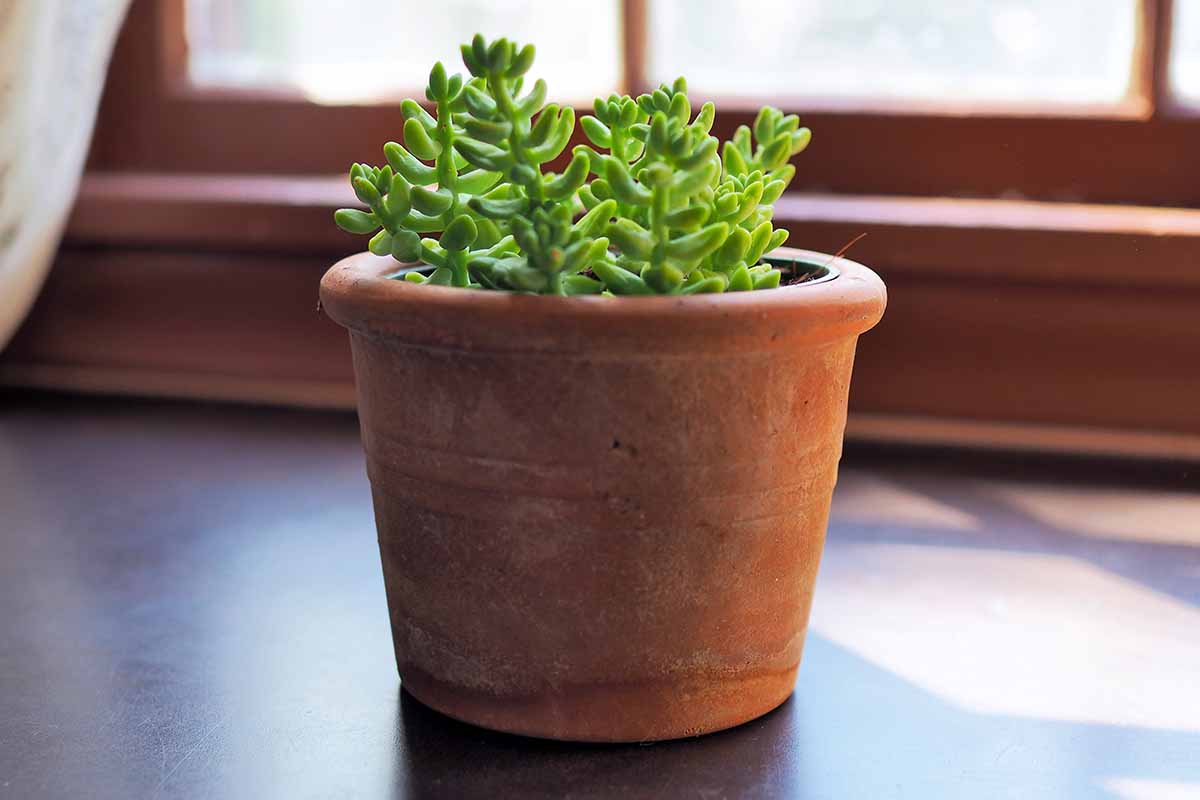
However, if exposed to too much direct sun, S. morganianum will lose its bluish color and take on a more yellowish-green hue.
Water
Although this species is a succulent and has great water storage capacities, it does not like to be allowed to go bone dry.
Instead, allow the top one to three inches of its soil to dry between waterings.
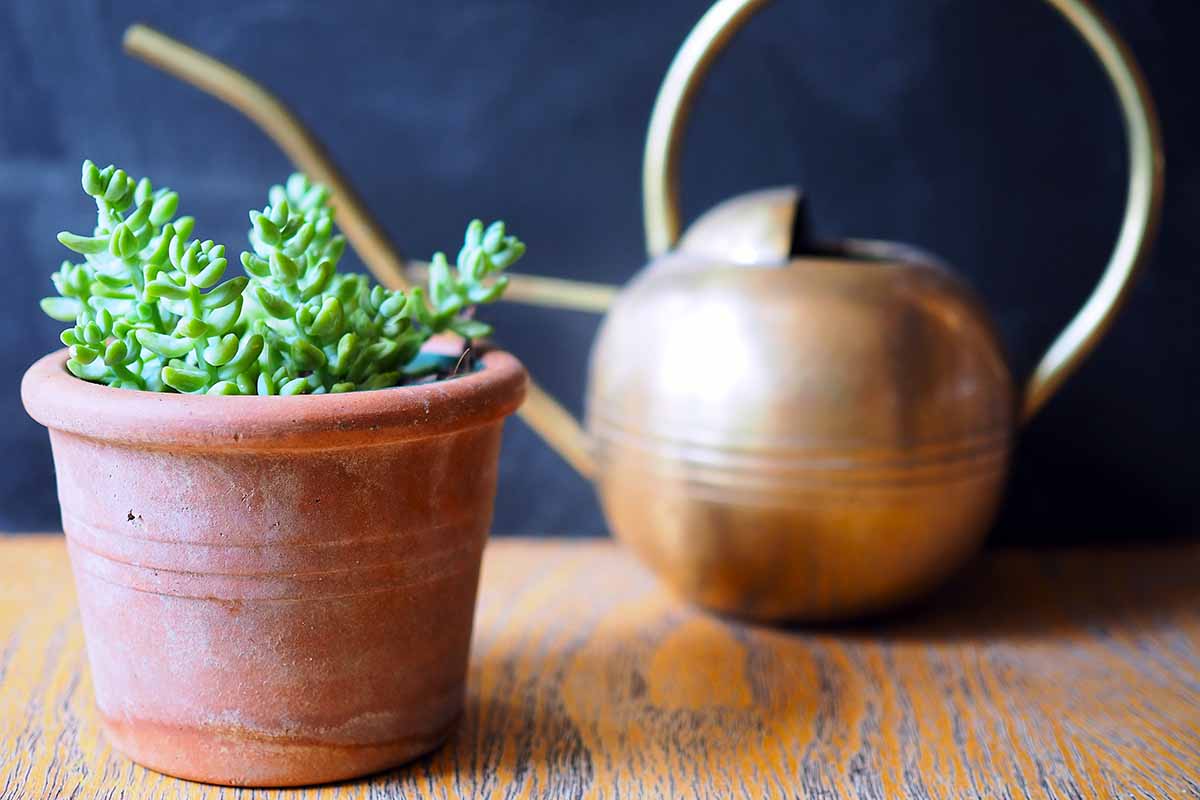
This may mean watering once a week during the growing season, but frequency will depend on various conditions such as the climate inside your home, the type of growing medium you choose, and the type of pot you select.
Terra cotta pots will allow specimens to dry more quickly than plastic or glazed ceramic.
Use room temperature water as part of your watering routine, and consider using a houseplant-adapted watering can with a narrow spout, in order to get in between the dense foliage of the plant to water the soil.
Do not water these plants from overhead – avoid sprinkling the leaves.
Check out a selection of some of our favorite houseplant watering cans in our article.
During the winter, reduce the frequency with which you water to account for shorter days, perhaps changing your watering routine to every 10 days to two weeks. You might want to check soil moisture levels with a moisture meter.
Soil
S. morganianum requires well-drained soil, and is flexible about its pH needs, thriving in growing mediums that are acid to alkaline.
Cactus and succulent potting medium will be a great choice for this sedum, such as Sun Gro Black Gold Cactus Mix.
This well-draining growing medium contains humus, perlite, pumice, and sand, and can be purchased in an eight-quart bag from Sun Gro Horticulture via Amazon.
You can also make your own potting soil for succulents, which we detail here.
Climatic Conditions
In its native range, donkey’s tail grows in a temperature range that tends to stay between about 45 and 85°F, so this succulent will be comfortable in average climate-controlled household conditions.

If placing these houseplants outdoors during summer, avoid windy areas since the leaves and stems can break off very easily.
As for humidity, its native growing conditions provide it with high humidity, but it tolerates the average humidity levels found in indoor conditions.
If you have very low relative humidity in your home, particularly during the winter, consider grouping donkey’s tail with other houseplants to raise the ambient humidity, or use a humidifier nearby.
Growing Tips
- Plant in well-draining succulent growing medium.
- Grow in bright, indirect light, with up to four hours of direct sun per day.
- Allow the top one to three inches of soil to dry between waterings.
Maintenance
Donkey’s tail doesn’t require much upkeep, but here are a few care tasks to keep in mind:
Fertilizing
S. morganianum doesn’t require frequent fertilizing to thrive.
It’s best to feed it with a gentle fertilizer designed for succulents once a month during the growing season.
Dr. Earth’s Succulence Cactus and Succulent Food
One such option is Dr. Earth’s Succulence Cactus and Succulent Food, which has a 1-1-2 NPK ratio, and is available for purchase in a 16-ounce bottle from Arbico Organics.
Be sure to follow the manufacturer’s instructions for applying this product.
And if you’d like to learn more about plant nutrients, read our article on what plants need and when they need it.
Handling with Care
As previously mentioned, the leaves of S. morganianum are prone to being knocked off of their stems, and when this happens over and over, specimens will have foliage that is less full, with patches of bare stem.
So, in order to keep the leaves of this plant on its stems, you’ll need to handle donkey’s tail with care.
Start by situating specimens in low traffic areas to avoid losing leaves to unintended bumps.
Next, when plants need to be moved, such as for watering, be sure to handle them carefully.
Finally, you’ll need to be extra careful when repotting. Keep reading for more tips on how to repot with minimal leaf loss.
Repotting
Repotting is probably the trickiest part of caring for a donkey’s tail succulent.
Luckily, these plants like to be rootbound, so this is not a project you’ll need to undertake frequently.
First, allow the plant to get a bit dehydrated before repotting since leaves are less likely to pop off when plants are dry.
Next, gather your repotting supplies.
You’ll need a growing medium designed for cacti and succulents, a few chopsticks or skewers, a couple of extra nursery pots to help elevate the specimen while it is transplanted (if yours has long stems), and a new plant pot that is just one size larger than the current pot.
These cliff-dwelling succulents don’t have extensive root systems, so a pot that’s on the shallow side will work fine, such as this cute ceramic hanging planter in the shape of a sloth, available at Amazon.

Whatever pot you choose, make sure it has drainage holes, and that it is sturdy enough to hold up under the weight of your specimen’s stems.
If the specimen has long stems, place it on top of an overturned pot, so the stems can hang down during this process.
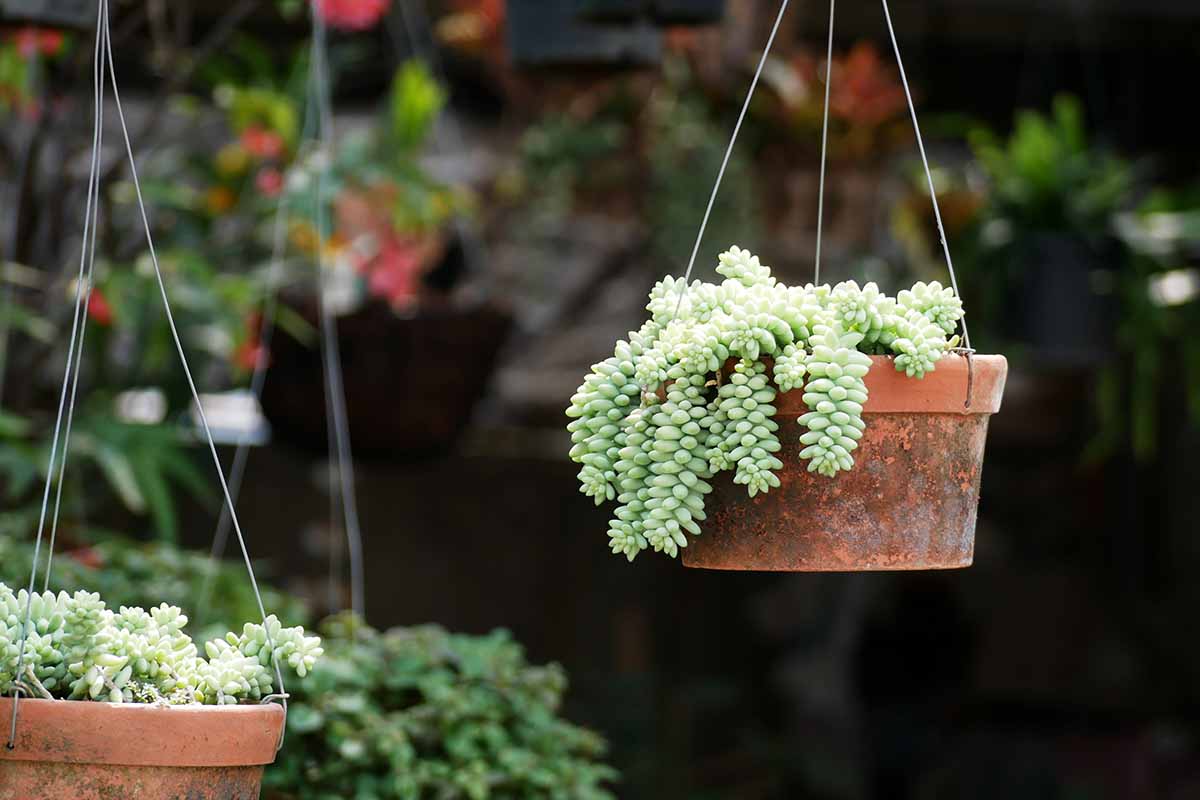
Prepare your new pot by adding a shallow layer of growing medium in the bottom, and elevate it as well, if needed, by putting it on another overturned pot.
Since this species has a dense root system, you can insert skewers or chopsticks into the root ball and use them as leverage to lift it out without touching the foliage.
Once the root ball is out of the pot, handle it only by the root ball instead of touching the foliage.
Place the root ball into the new pot. Make sure to situate it so that there is an inch of space between the surface of the soil and the rim of the pot – adjust the amount of growing medium in the bottom of the pot if needed.
Once the plant is in the new pot, gently lift up each stem one by one and fill in with growing medium.
Water it in and return your specimen to its usual location.
Pruning
Donkey’s tail succulents don’t require pruning, but this is a maintenance task plant owners can use to reshape the specimen or restrict its growth.
Pruning will encourage branching, so if you want a very voluminous-looking plant, this is one way to achieve that.
Also, plants with very long stems can be difficult to handle, so pruning is a way to keep them at a more manageable size.
Any trimmed stems can be propagated into new plants, which can be added to your collection or offered as gifts.
Encouraging Blooms
The flowers of S. morganianum aren’t exactly the main attraction, but it’s always fun to see blooms on a houseplant.
So, if you’re interested in trying to get this succulent to bloom, there are a few steps you can take for better success.
First, understand that only longer stems produce flowers – they need to be at least 10 inches long.
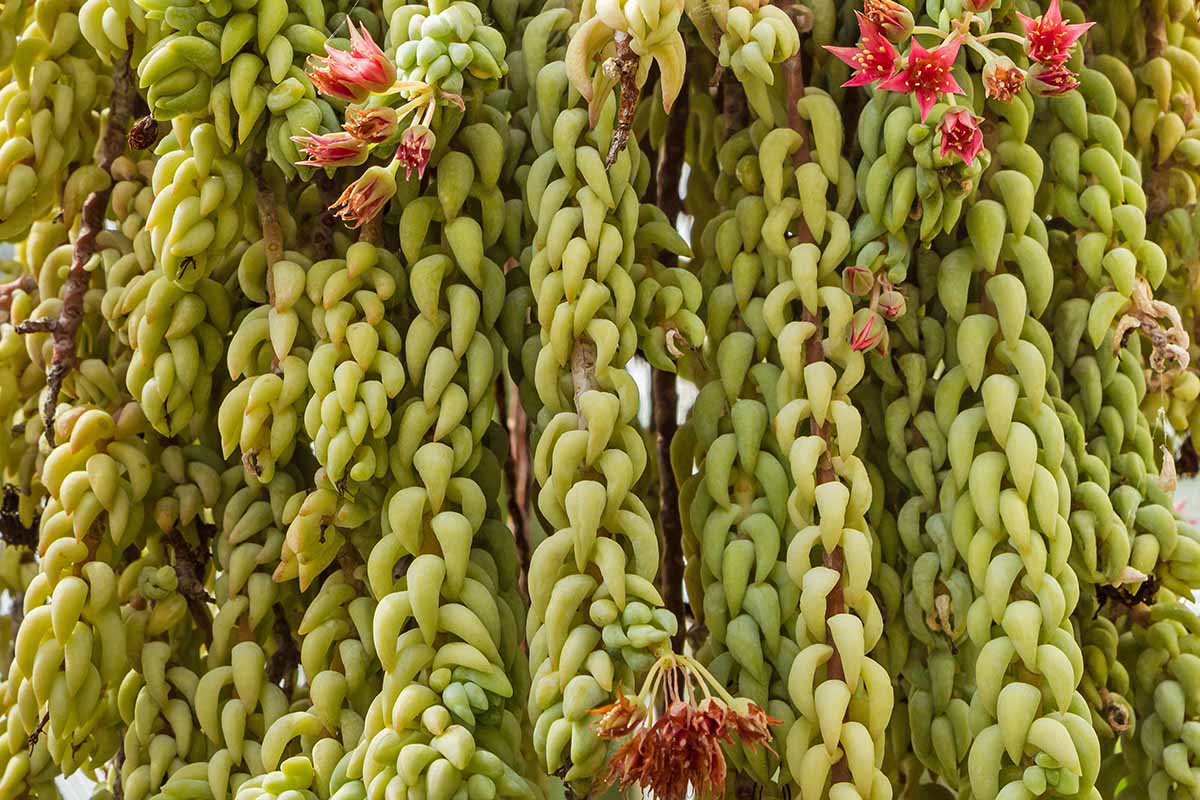
Next, gardeners tend to have better success getting flowers from specimens that have some outdoor time, so offer your sheep’s tail a little vacation in the open air when and if your climate permits.
If you’re not sure, double-check the section on climatic conditions above – these succulents shouldn’t be subjected to strong winds or torrential downpours.
Finally, exposing plants to cooler temperatures during the winter will also help stimulate bloom production. Aim for temperatures in the 50s or 60s.
Species and Varieties to Select
When it comes to donkey’s tail varieties and hybrids, there are a few different options to explore. Here’s what you’ll find:
Morganianum
S. morganianum is the straight species. It has pointed, fleshy leaves, and its foliage is bluish green.
Donkey’s Tail Succulent in 4” Hanging Basket
You can purchase a donkey’s tail specimen in a four-inch mini hanging basket from Hirt’s Gardens via Walmart.
Burrito
Often called “burro’s tail” or “baby burro’s tail,” the jury is still out on whether this plant is a cultivated variety of S. morganianum, or a separate species.
Botanists consider it either a cultivated variety of the species, classified as S. morganianum ‘Burrito,’ or as a separate species, classified as S. burrito.
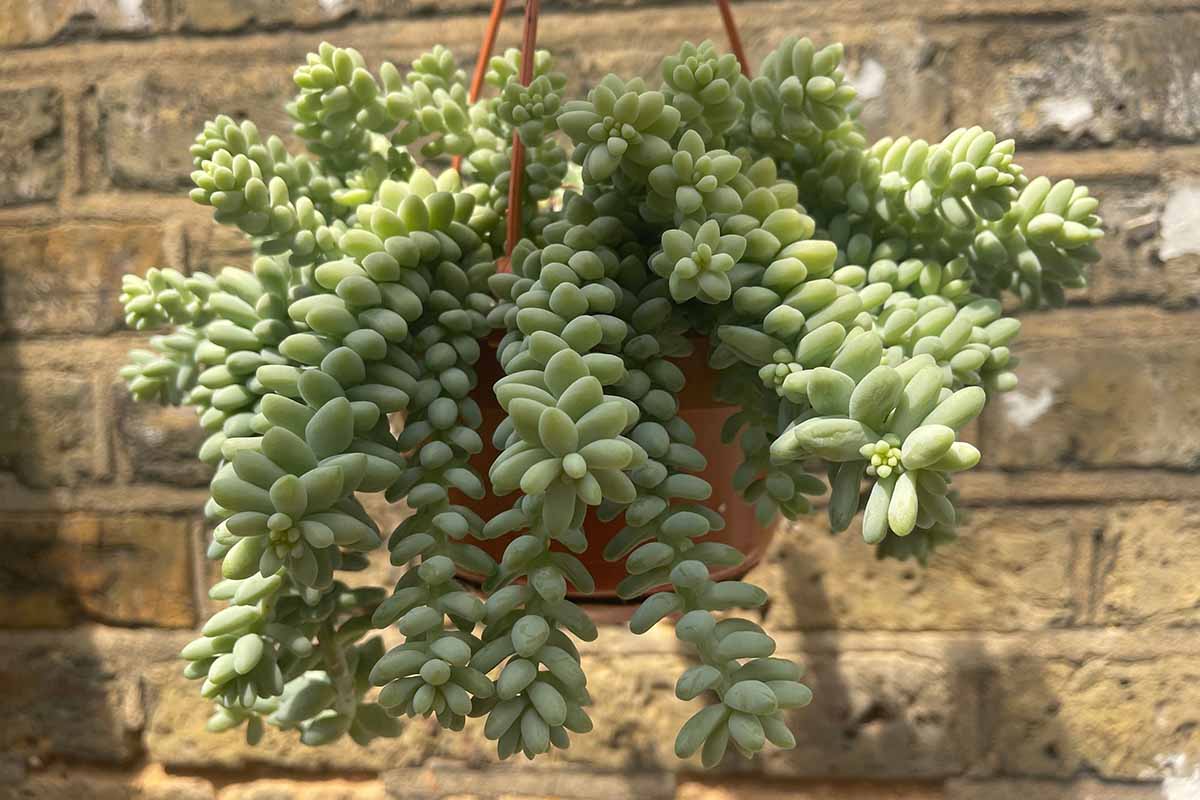
One of the arguments in favor of this plant being a cultivar rather than a separate species is that it has never been found in the wild.
However, until 2008, the same could have been said for S. morganianum.
Compared to S. morganianum, baby burro’s tail has shorter, rounder leaves, shorter flowers, and more compact growth.
As for growth habit, donkey’s tail has a slightly spiky appearance thanks to its pointed leaves, while the leaves of burro’s tail give that plant a knobbier look.
Also, the leaves of baby burro’s tail don’t fall off quite as easily as those of S. morganianum.
Nonetheless, care needs for burro’s tail are similar to those of donkey’s tail.

Baby Burro’s Tail Succulent in 2”, 4”, or 6” Pot
You can purchase a baby burro’s tail houseplant in a two-, four-, or six-inch pot from the Succulents Box Store via Amazon.
Giant Burro’s Tail
Giant burro’s tail is an interspecies cross that was created by Dr. Meredith Morgan, the optometrist and succulent enthusiast who is honored by the species’ name.
This plant is a cross between S. morganianum and either S. treleasei or S. stahlii.
Classified botanically as S. x ‘E.O. Orpet,’ the bluish “tails” of this hybrid are shorter and thicker than those of the straight species.
Harry Butterfield
Classified as x Sedeveria ‘Harry Butterfield,” this intergeneric hybrid is a cross between S. morganianum and Echeveria derenbergii.
It’s sometimes referred to as “super burro’s tail.”
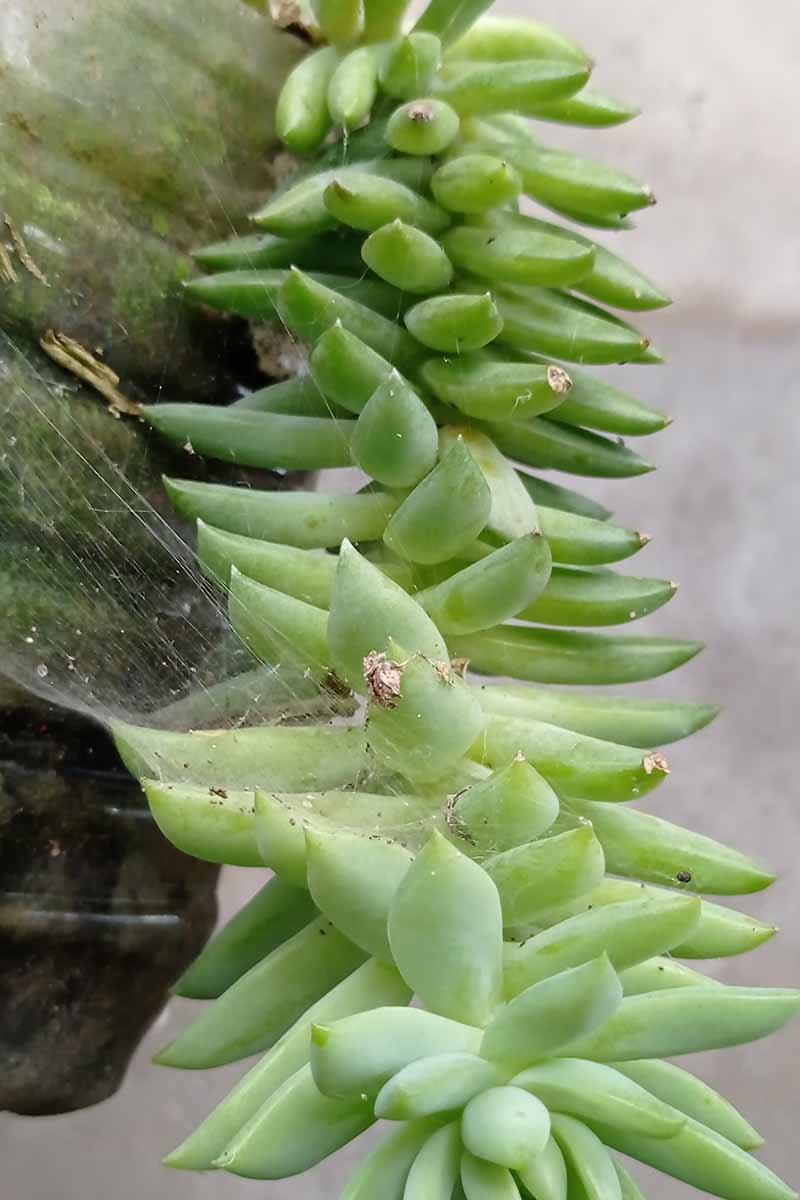
This plant has a sprawling growth habit, with stems reaching at least 12 inches long, and foliage that is bluish-green.
When in flower, blooms are yellow and pink or yellow and red.
‘Harry Butterfield’ Succulent in 2” Pot
Purchase a ‘Harry Butterfield’ specimen for your collection – you’ll find one in a two-inch pot from Yunakesa via Amazon.
Managing Pests and Disease
This stonecrop tends to stay free of pest and disease problems.
For those who locate their sheep’s tail outdoors for the warm months of the year, be wary of snails and slugs, as well as other animals who may enjoy snacking on the water-filled leaves of this succulent.
Mealybugs are the most common insect pest to attack this houseplant, and they can be eradicated with repeated applications of nontoxic neem oil. Be sure to follow the manufacturer’s instructions for applying the product.
Aphids can also sometimes be a problem, but can often be removed with just a jet of water. Be careful to make sure that jet of water isn’t too strong, or you might blast all the leaves off of the stems.
You can learn more about controlling aphids in our article.
As for disease, root rot is the most likely plant illness you may encounter, but it can be avoided with good drainage and proper watering. Be sure to review the watering and soil sections of this article if you’ve encountered this plant disease before.
Best Uses
Donkey’s tail is a versatile houseplant that can create an impact as a focal point or blend into a grouping of other houseplants.
If stems are allowed to grow long, this succulent will do best kept in an elevated planter or hanging basket – in fact, it’s one of the best hanging and trailing succulents out there!
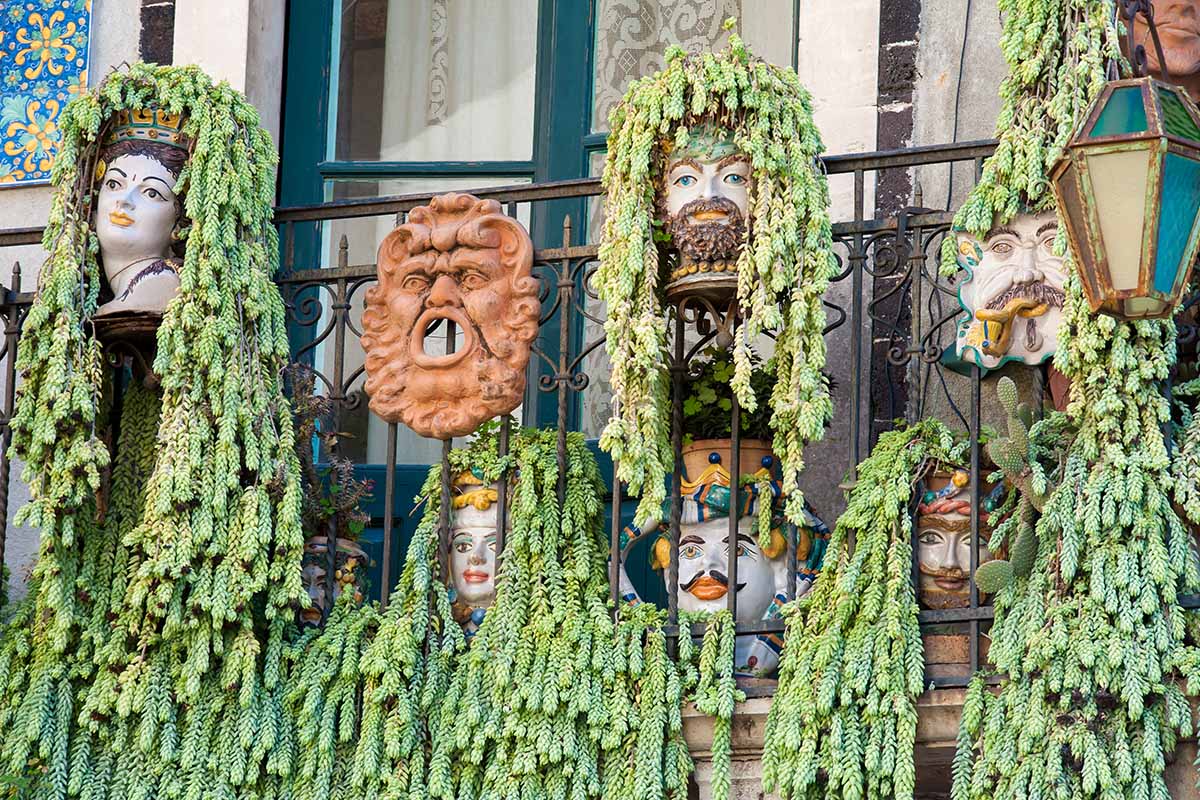
It can also be used for interiorscaping, or to create a green wall.
For those looking for a whimsical idea, the stems of donkey’s tail can provide the “hair” for a bust or head-shaped planter, such as this wall mounted, distressed planter in the shape of a woman’s head, available via Amazon.

Wall Mounted Cement Head Planter
And, since this species is nontoxic to pets and humans, it can be displayed safely in households with curious tots or fur babies.
Just make sure to keep it out of reach to protect its delicate leaves – and to prevent heavy pots from being pulled down from shelves.
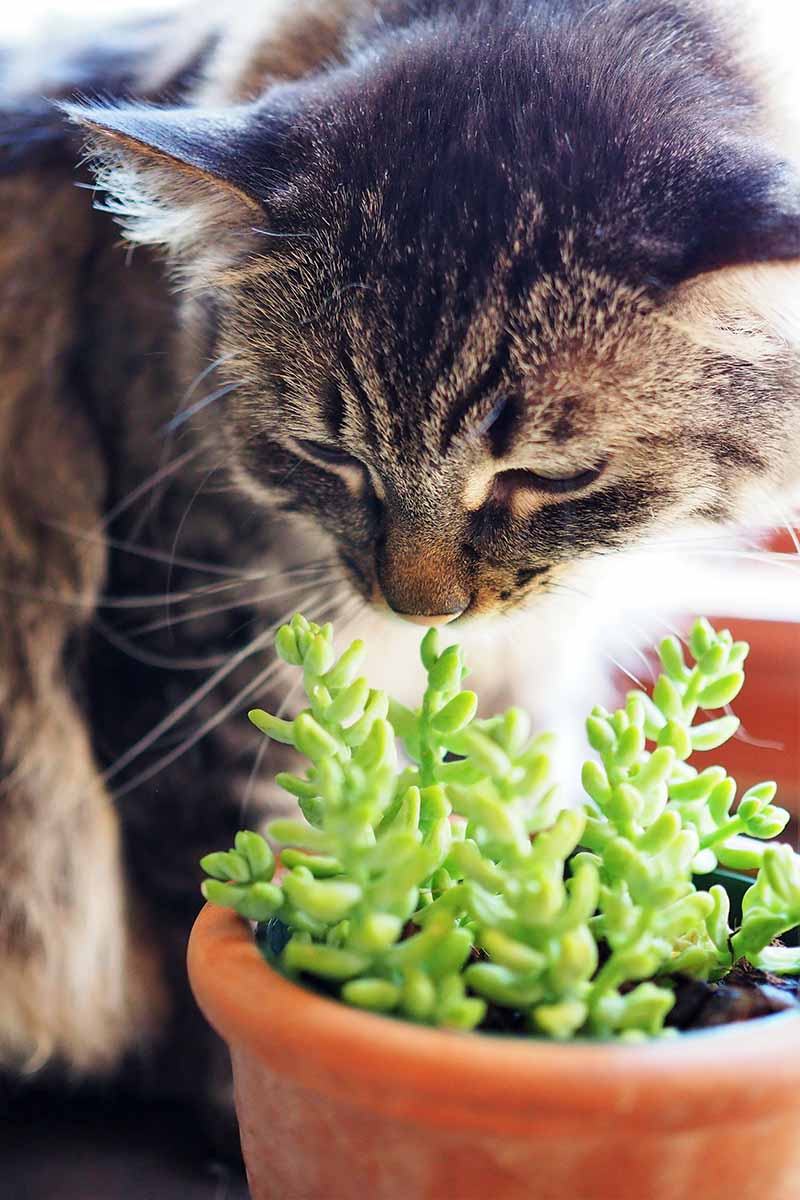
For outdoor use in USDA Hardiness Zones 10b to 11a, sheep’s tail looks great spilling out of planters on the edge of a railing or balcony, and can also be allowed to trail and cascade in a rock garden.
Quick Reference Growing Guide
| Plant Type: | Succulent | Flower / Foliage Color: | Pink to red/Bluish-green to pale green |
| Native to: | Veracruz, Mexico | Maintenance | Low |
| Hardiness (USDA Zone): | 10b-11a | Tolerance: | Drought, humidity |
| Bloom Time: | Late spring to early summer | Soil Type: | Cactus and succulent potting medium |
| Exposure: | Indirect bright light with <4 hours direct sun | Soil pH: | 6.6-7.8 |
| Time to Maturity: | 2-5 years | Soil Drainage: | Well-draining |
| Planting Depth: | Top of root ball even with soil surface | Companion Planting: | Bromeliads, orchids |
| Length: | 4 feet | Uses: | Elevated planters, green walls, hanging baskets, interiorscaping, nontoxic houseplant, rock gardens |
| Spread: | 1.5 feet | Order: | Saxifragales |
| Growth Rate: | Moderate | Family: | Crassulaceae |
| Water Needs: | Low to moderate | Genus: | Sedum |
| Common Pests and Diseases: | Aphids, mealybugs, scale, vine weevils; root rot | Species: | Morganianum |
Suspend This Comely Cliff Hanger
Now that the origins of this species have been resolved and you are equipped with all the knowledge you need to properly situate and care for this striking houseplant, I hope you feel that growing S. morganianum is no mystery at all!
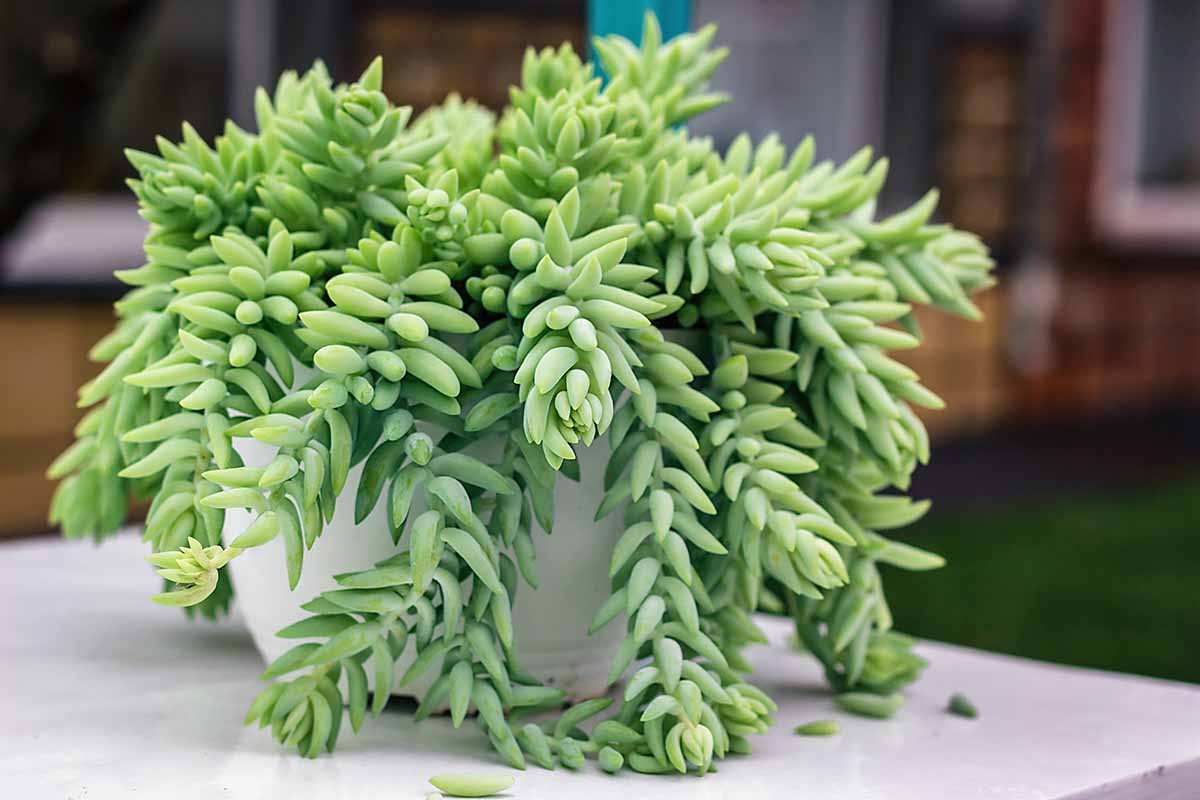
Do you have any tips of your own for caring for donkey’s tail that you’d like to share with our readers? Are you having any problems with your own specimen?
Trying to figure out whether your houseplant is a donkey or a baby burro? Feel free to let us know and share your photos in the comments section below!
And if you’re looking to increase your knowledge of cacti and succulents, we have more helpful articles for you right here:

